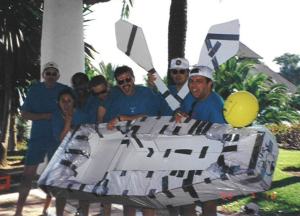Tag: Bonding
 Ok, this is a little bit of a teaser…we are in the process of doing a major overhaul of how we look at the 4-Drive Model. We’ve talked about the need to update this model before (see here and here). We are underway in getting that developed and should be launching it the first quarter of 2011.
Ok, this is a little bit of a teaser…we are in the process of doing a major overhaul of how we look at the 4-Drive Model. We’ve talked about the need to update this model before (see here and here). We are underway in getting that developed and should be launching it the first quarter of 2011.
Here is a sneak peak…the four main motivations as we’ve defined them are now renamed and constitute different elements:
1. Personal Motivation- focus on the intrinsic motivators that we have and encompasses the Drive to Challenge & Comprehend
2. Reward Motivation- focus is on the extrinsic motivators that we have and encompasses the Drive to Acquire & Achieve
3. Social Motivation- focus is on the social drives that motivate us and includes the Drive to Bond & Belong
4. Passion Motivation (this name is still being hotly debated – but for now its what we are running with)… – focus is on the motivational element of purpose and passion – including defending one’s honor and tribe
We know teams
We do a lot of work helping improve how teams operate. Some of it is straight old fun team building – you know the type where you go off-site for a day and do different types of games and activities (note – some people love these types of programs and others detest them with a passion). Other programs we do are much more intense and involve really working on specific team issues and developing action plans for greater collaboration, communication, or productivity.
We’ve worked with big teams. We’ve worked with small teams. We’ve done programs for executives and for line-workers. We’ve worked with teams that are working well and just want to get to that next level and teams that really are on their last leg and need immediate urgent care or they will implode.
We have done one hour fun sessions. We’ve created on-going programs that last months and require intensive work by the participants.
Regardless of the type of team development we are doing – it is also part of building a more motivational organization.
I was in South Dakota last week on a family vacation. First off, I forget how beautiful South Dakota is and all that it has to offer. Secondly, there are some really, really humongous carvings there…
Mount Rushmore
The original idea for Mount Rushmore is credited to South Dakota historian Doane Robinson who thought that it would increase tourism (he was a pretty insightful man). His idea was to carve local famous people into some of the granite mountains of the Black Hills. In 1924, after working on Stone Mountain, GA, sculptor Gutzon Borglum was brought in to carve the mountain.
Borglum expanded on the original idea and wanted it to be a National monument that focused on our presidents. He insisted that his life’s work would not be spent immortalizing regional heroes but insisted that the work demanded a subject national in nature and timeless in its relevance to history.
Borglum started work on Mt. Rushmore in 1927 at the age of 60. He worked the rest of his life on the mountain.
 The 4-Drive Model of Employee Motivation’s second drive is the drive to Bond & Belong. The drive is defined by our innate desire to form “close, positive relationships” with people around us. The image of the lone wolf going it alone or the inventor holed up in his workshop are atypical – most people want to bond with others and feel they belong to a group. Here are three tips to increase the B Drive:
The 4-Drive Model of Employee Motivation’s second drive is the drive to Bond & Belong. The drive is defined by our innate desire to form “close, positive relationships” with people around us. The image of the lone wolf going it alone or the inventor holed up in his workshop are atypical – most people want to bond with others and feel they belong to a group. Here are three tips to increase the B Drive:
This was our most viewed slideshare presentation with over 14,000 views – I’ve now turned it into a 4-minute youtube video….with music and everything. Hope you enjoy and please forward on to anyone you think would benefit from watching.
Oak Ridge Hotel and Conference Center get motivation – it isn’t about a single program or special one-day events. . . it is about creating a culture that engages and motivates.
Here is a short video that highlights some of what we found out when we talked with them and asked them. . . “What Motivates You?”
Are 140 Characters Considered a Bonding Moment?
Have you ever noticed that when you are speaking with your colleagues that much of the conversation revolves around surface level things? Things such as the weather, project updates, weekend plans, and the recipe for the great veggie dip from the potluck lunch.
As improbable as it sounds, it seems like there are often more in-depth conversations going on within social media sites like facebook and Twitter than between colleagues in the workplace. There seems to be a shift in how we interact with each other that is taking place. This new form of conversation can reveal a more authentic side of people. Is it because it is easier to connect with others who you may not know? When I sit down and stare at my Twitter home page I am 140 characters away from connecting with hundreds, if not thousands, of people around the world. This is appealing in many ways for us as we truly enjoy connecting with people. Technology has made connecting with individuals from anywhere in the world very easy to do. The dark side of this is that when we log off Twitter or facebook we can feel like we are missing something. Are we missing an opportunity to bond with someone?
The 4-drive theory shows us that the drive to bond is a fundamental human drive. People can recognize and understand it immediately when it is happening real time. As human beings we have a drive to connect with other people and the depth of those connections will vary based upon your relationships with them. We bond differently with different people, at different points in our lives and for different reasons. The common aspect is the desire to have a positive relationship with other another human being. We do this through sharing stories, exchange ideas, and listening to one another.
The question is this – how does technology impact our drive to bond? Can the drive to bond be satisfied 140 characters at a time? Do we need to have the happy-hour hang out scene after work in order for this drive to be filled, or can we bond effectively without ever meeting a person face-to-face? Is technology becoming just another avenue for us to bond or is it shifting the very nature of the bonding experience?
Based upon our limited experience, we feel that technology is shifting the very nature of our interactions. The ability to share thoughts and ideas with the world, changes how we communicate. That change can also impact how we connect with others. It provides opportunities for greater sharing and more revealing conversations. For many people, it is easier to tweet about a thought or idea than it would be to share that thought or idea coworkers. On this level, it can foster greater bonds. However, we’ve also realized that there is power to having face-to-face sharing. When Susan attended Blogwell, she met many tweeters on the bus and at the conference and because of the human aspect of meeting them in person, she was able to bond faster and with more trust. The real potential, as we see it, is in being able to meld these two forms and garner both the emotional aspects of face-to-face bonding with the deeper insight and discussion that often comes with the help of the electronic word.
We would welcome your thoughts and comments?
We all have a drive to bond. The desire to form meaningful, positive relationships with those around us. Research shows that this drive is one of the strongest motivators that we have as humans (see Baumeister & Leary, 1995; Lawrence and Nohria, 2002). Think of the impact that this strong human drive could have on business performance if harnessed? Think of the extra effort that you exert for your friends when they are in need – now apply that extra effort to a business.
The problem is that businesses typically see bonding only as something done in a team building session for an afternoon at the National Sales Meeting. Or worse, that bonding is idle chit-chat that steals company time and resources. How many organizations have you seen with policies regarding time spent away from the desk, on the internet, or using social media at work? Think about those companies that have strict policies regarding office fraternizing or dating. Or think of the norms that have been established about not mingling with your employees or being their friends after work. All of this is wrong!
Now I understand that there are reasons for these policies (legal issues, productivity lost, sandbaggers, etc.). The fact is, these policies inhibit bonding and socializing at work. The fact is, that bonding can be used to help motivate and inspire your workforce to higher productivity, more responsibility, and greater results. The issue is that companies need to pro-actively work on this – and that’s not easy.
There are a number of ways to foster increased bonding. Th first is to remove the roadblocks that inhibit socialization. Examine your policies and procedures to see if they can be eliminated or changed to help people get to know one another without serious loss of productivity. Then focus on creating a culture that encourages bonding and team work. Create opportunities for people to meet and discuss. Foster conversations between groups and levels within the organization. Identify social media tools to help people get to know one another on a more personal basis.
Here are a just a couple of ideas:
- Create a breakfast/lunch topics series – have people give a short presentation on a topic of their interest
- Start a job sharing/learning forum – one of the best ways to form a relationship at work is to help people understand what everyone does and how they do it
- Start each meeting with fast facts – a quick go around about something each person has recently done or is planning on doing
Give us some ideas of yours – we’ll not only post them here, but also on Twitter!





